Mar 22, 2009
Video Interviews at the ICCC, Elsewhere
Reporters from TheNewAmerican.com
The second International Conference on Climate Change concluded its 2-1/2 -day run March 10, 2009 in New York City after confronting the theme “Global warming: Was it ever really a crisis?”
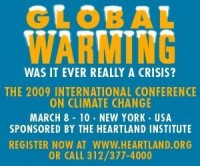
The answer was a resounding “No.” Here are some of the early youtube videos from the conference. There will be many more available in the weeks ahad and we will maintain them in a master list.
Henry Lampman, reporter for The New American interviews Willie Soon, Phd, Chief Science Advisor at Science and Public Policy Institute at the International Global Climate Change Conference in New York City March 2009
Henry Lampman, reporter for The New American interviews Dennis Avery, Senior Fellow at Hudson Institute on Global Warming at the International Conference on Global Climate Change in New York City March 2009
Ed Hiserholt, reporter for The New American interviews Dr David Evans at the March 2009 International Conference on Global Climate Change in NYC.
Hal Shurtleff, reporter for The New American interviews Roy Innes National Chairman Congress of Racial Equality (CORE) at the March 2009 Conference of Global Climate Change in New York City.
Ed Hiserholt, reporter for The New American interviews Lord Christopher Monckton at the March 2009 International Conference on Global Climate Change.
Hal Shurtleff, reporter for The New American interviews Tom DeWeese, President American Policy Center. Hal asks Mr. DeWeese about Law of the Sea TREATY (LOST) and the ICCC.
John Coleman sings the Nah-Nah Goodbye Global Warming song at the Conference on Global Climate Change in New York CIty March 2009
Hal Shurtleff, reporter for The New American interviews John Coleman on “What’s/Who is behind the ‘Global Warming Hoax’ at the International Conference on Global Warming Climate Change in New York
Henry Lamkin, reporter for The New American interviews Joanne Nova, author of “The Skeptic’s Handbook”. Joanne Nova believed in manmade warming by carbon dioxide emissions from 1990-2007. Not any more!
Henry Lampkin, reporter for The New American interviews Dr. Tom Segalstad, Head of the Geological Museum at Univ. of Oslo during the International Conference on Global Climate Change in New York City - March 2009
The the full proceedings with videos of the keynote addresses and Introductions and the powerpoint and PDFs here. More videos of the talks will be posted in upcoming days.
Gore was invited again but ignored the invitation. He is featured in a mock debate here with 7 scientists on The American Thinker here.
And finally, this interview with liberal democrat Harold Ambler here.
Hansen’s talk in Oslo courtesy of Paal Brekke of the Norwegian Space Centre.
There are many ‘End of Days’ theories about the year 2012, but what many may not know is that even some scientists say there is a possibility that a solar event could occur and present problems for hundreds of millions of people by affecting power grids and satellite communications. But although such an impactful solar storm will eventually occur, no one can say where or when (2012 or2065?). FOX25’s Kevin Lemanowicz interviews Dr. Willie Soon and Joe D’Aleo here.
See this new video Stop Global Whining By Justin C here.
Mar 22, 2009
Recent Ocean Heat and MLO CO2 Trends
By Anthony Watts, Watts Up With That
One of the great things about running this blog is that people send me things to look at. Sometimes I see connections between two things that were initially unrelated by the original messages. This is one of those cases.
Dr. Roger Pielke Sr. suggested back in 2003 in a peer reviewed BAMS paper, that “it is the change in ocean heat content that provides the most effective diagnostic of global warming and cooling.” Recently at ICCC 2009, Dr. Craig Loehle did a presentation titled “1,500-Year Climate Cycles, Broken Hockey Sticks, and Ocean Cooling” (PowerPoint) which talked about the ocean heat content.
I was reminded of one of his graphs from that presentation by a recent post on Jennifer Marohasy’s blog. For your viewing pleasure, using graphic editing tools, I created a slightly larger and annotated version, shown below and enlarged size here:
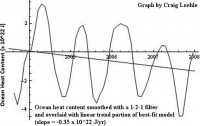
The next day, on an email list I subscribe to, Alan Siddons sent along this graph with this note: “hought youíd like to see the Mauna Loa rate of CO2 change up to now. Kind of odd these recent years.”
I didn’ think much of Siddons’ graph initially, but as luck would have it, I happened to have Loehle’s graph open in a desktop window from Jennifer’ blog. I noticed something interesting and unexpected looking at the two.
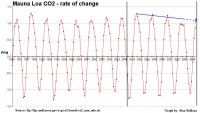
Clearly something is happening to heat content within our oceans, whether it is a flat trend or yet unrecognized loss of heat, remains to be hashed out. The year 2008 was a cooler year globally, and there is quite a bit of measured as well as anecdotal (weather event) data to support that. Our oceans are in fact the planet’s largest heat sink, and it has been routinely demonstrated that changes in that heat sink status (AMO, PDO, El Nino and La Nina) do in fact affect our weather and climate. It makes sense, as the heat content of the oceans drops, CO2 solubility in seawater increases, and thus we see an absorption of CO2 and dampening of the annual peaks in the rate of change. Obviously this is just a simple visual analysis, and I don’t pretend to know everything there is to know about either of these subjects or datasets, but I thought the serendipity of these two pieces of initially independent and unrelated graphs of data was interesting and worth discussing.
Allan Siddons has provided two additional graphs. The first being an overlay of MLO monthly data on MSU oceans data
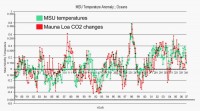
The second is a 12 month average of MLO CO2 rate overlaid on my RSS MSU land and ocean graph posted originally.

It seems clear that there is a CO2 rate of change response that mirrors global temperature. Bob Tisdale has also provided some similar graphs via many links made in the comments. Be sure to have a look. - Anthony
See full post and comments here.
Including this from Jergen F. “same thing with sea levels. The trend broke around 2005-2006”
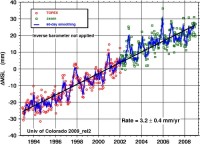
Mar 22, 2009
History Made as Jones et al 2008 Paper Admits Huge Urban Warming in IPCC Flagship CRUT3 Gridded Data
By Warwick Hughes
So sceptics have been correct for decades.
Yes you have to pinch yourself, the old canard so long clung to by the IPCC, that the urban influence in large area gridded data is “an order of magnitude less than the warming seen on a century timescale” is now severely compromised.
The IPCC drew that conclusion from the Jones et al 1990 Letter to Nature which examined temperature data from regions in Eastern Australia, Western USSR and Eastern China, to conclude that “In none of the three regions studied is there any indication of significant urban influence.” That has led to the IPCC claim that for decades, urban warming is less than 0.05 per century.
Now Jones et al 2008 are saying in their Abstract, “Urban-related warming over China is shown to be about 0.1 degree per decade”, hey that equates to a degree per century. Huge. See Warwick’s post here.
As Alan Siddons notes “...a lot of post-correcting is called for now. Ths is what I get when I coordinate Hadley and GISS global temperatures with the MSU satellite record.”
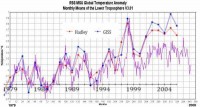
See larger image here See alternmative version courtesy of Junk Science here.
Icecap Note: The GISS US data which is UHI corrected using night lights shows a 0.75F difference (cooler) from the NOAA NCDC USHCN version 2 where UHI was removed.
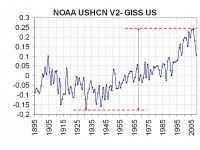
See larger image here.
This is equivalent to the 1F rate per century mentioned above. So, as we have been stating over and over again and I presented in NYC at the Heartland ICCC, MUCH OF THE LONG TERM TREND attributed to CO2 may be UHI induced errors in the global (and USHCN) data bases.
Mar 21, 2009
The Oceans Really Are Cooling
By Jennifer Marohasy
THERE are 3,000 free-drifting buoys in the world’s ocean; first deployed in the year 2000 they allow continuous monitoring of the temperature, salinity, and velocity of the upper ocean. There has though been some difficulty in interpreting the data from these buoys. Initial signs of cooling were dismissed as due to technical errors subsequently corrected based on a small sample of the 3,000 buoys known as profiling floats.
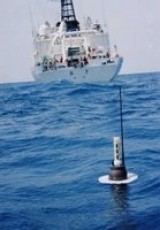
Craig Loehle has analysed the data from only the profiling floats for ocean heat content from 2003 to 2008. In a paper recently published in the journal Energy and Environment he has concluded that there has been ocean cooling over this period. This graphic is from figure 1 of the technical paper and shows the decline in ocean heat content (x1022J) smoothed with a 1-2-1 filter.
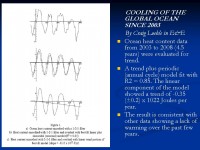
See larger image and abstract here.
Dr Loehle’s findings are consistent with satellite and surface instrumental records that do not showing a warming trend over recent years.
*************************
Notes:
Craig Loehle is a senior scientist at the Illinois-based ‘National Council for Air and Stream Improvement’. Cooling of the global ocean since 2003. Craig Loehle, 2009. Energy and Environment. Volume 20.
Argo (free-floating buoys) Homepage
Apologies to Josh Willis: Correcting Global Cooling (Part 3), NASA Changes Data to Fit the Models Adjusts Data from Buoys, Global Warming’s Missing Heat .
Mar 19, 2009
Reality Check: Shell Dumps Wind, Solar and Hydro Power
By Tim Webb, The Guardian. Hat Tip Dr. Benny Peiser CCNET
Shell will no longer invest in renewable technologies such as wind, solar and hydro power because they are not economic, the Anglo-Dutch oil company said today. It plans to invest more in biofuels which environmental groups blame for driving up food prices and deforestation.
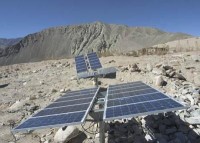
Executives at its annual strategy presentation said Shell, already the world’s largest buyer and blender of crop-based biofuels, would also invest an unspecified amount in developing a new generation of biofuels which do not use food-based crops and are less harmful to the environment.
The company said it would concentrate on developing other cleaner ways of using fossil fuels, such as carbon capture and sequestration (CCS) technology. It hoped to use CCS to reduce emissions from Shell’s controversial and energy-intensive oil sands projects in northern Canada.
The company said that many alternative technologies did not offer attractive investment opportunities. Linda Cook, Shell’s executive director of gas and power, said: “If there aren’t investment opportunities which compete with other projects we won’t put money into it. We are businessmen and women. If there were renewables [which made money] we would put money into it.”
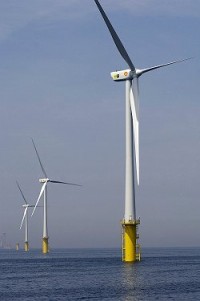
Shell said biofuels fitted its core business of providing fuels, logistics, trading and branding. Cook added: “It’s now looking like bio≠fuels is one which is closest to what we do in Shell. Wind and solar are interesting [but] we may continue to struggle with other investment opportunities in the portfolio even with big subsidies in many markets. We do not expect material investment [in wind and solar] going forward.”
Until recently, Shell’s investment in wind power featured prominently in its corporate advertisements. FoE said the company’s move heralded a slightly more honest approach. “Shell is at least being a bit more honest about the fact they are a fossil fuel company. It has seen the limitations of the greenwash it was putting out a few years ago.” Read more here.
|














